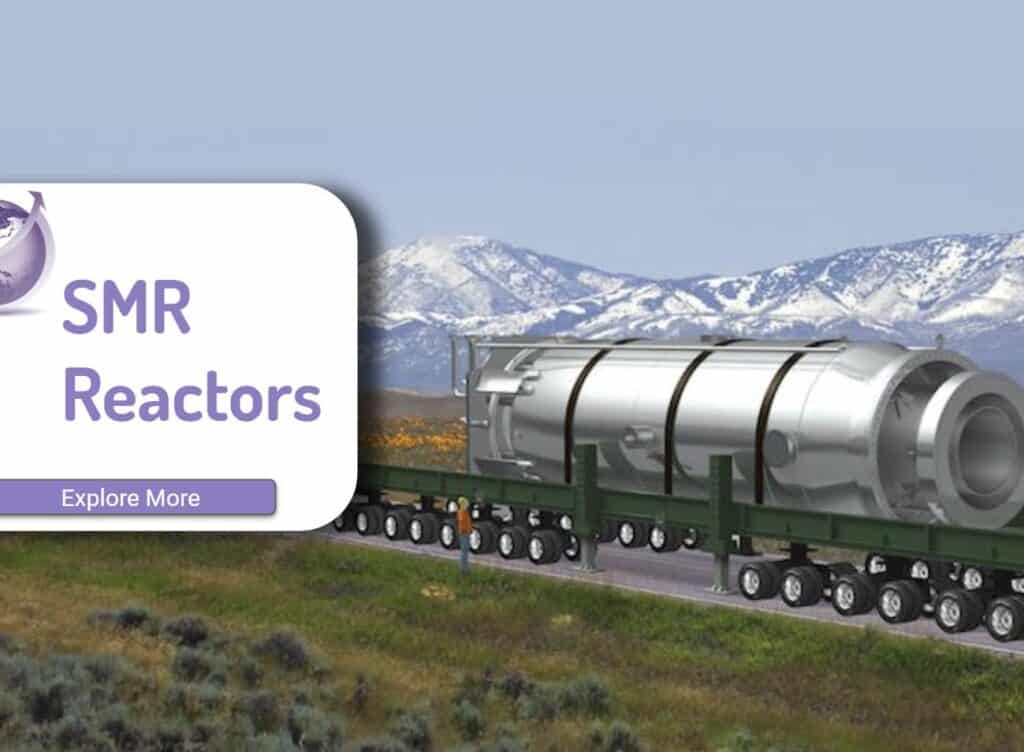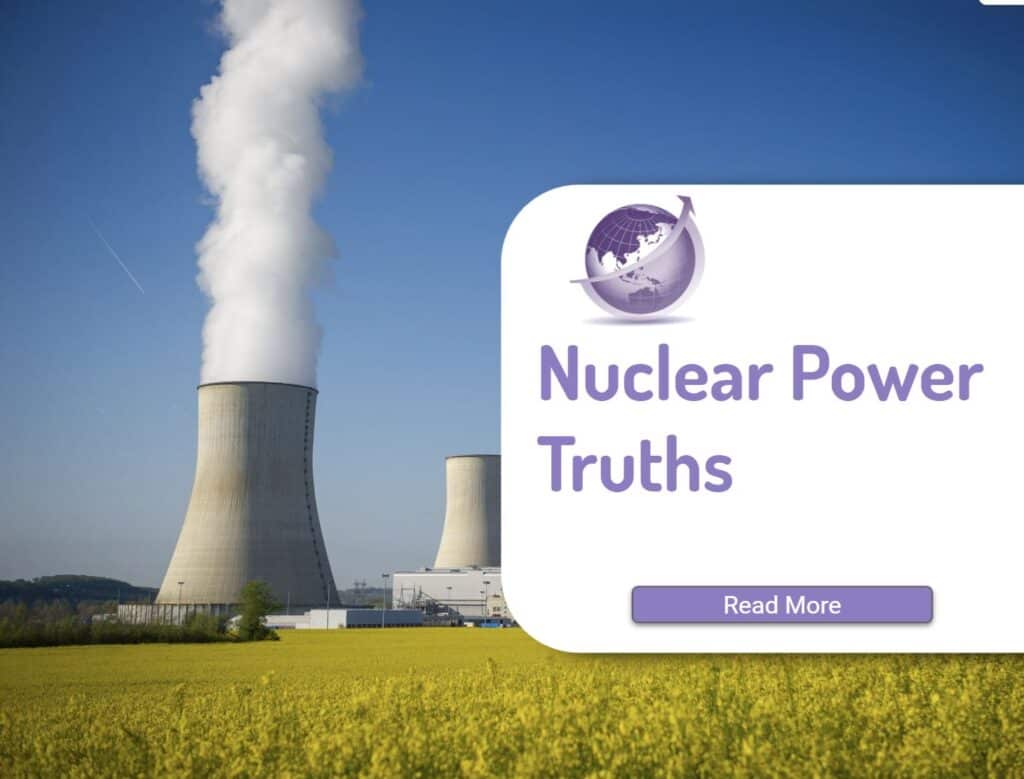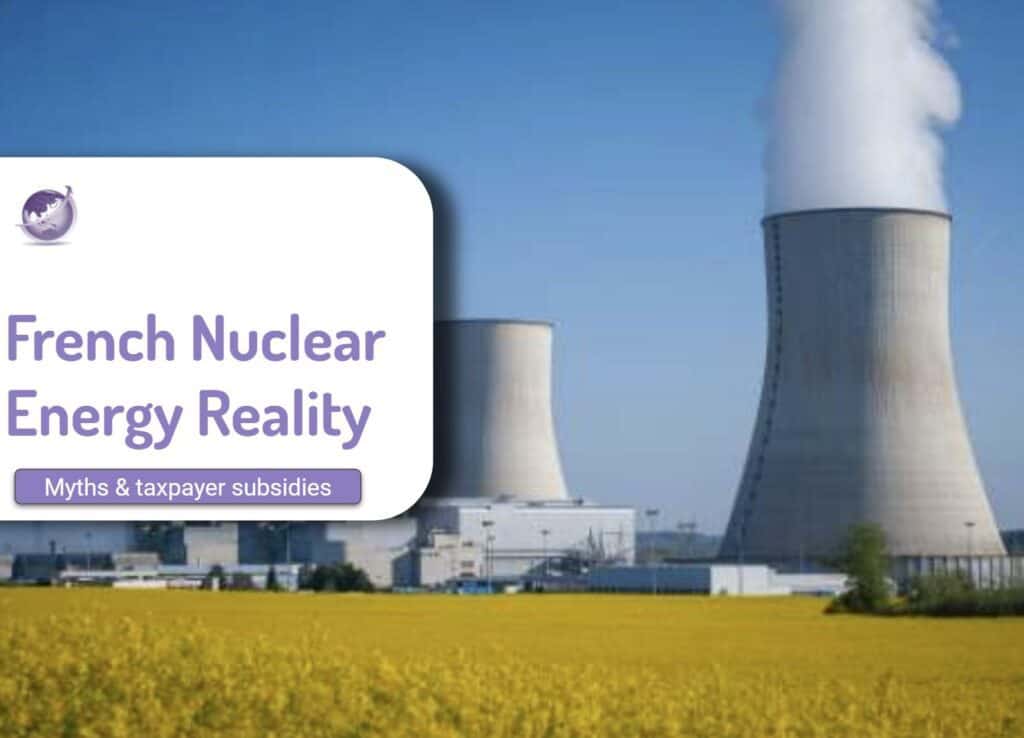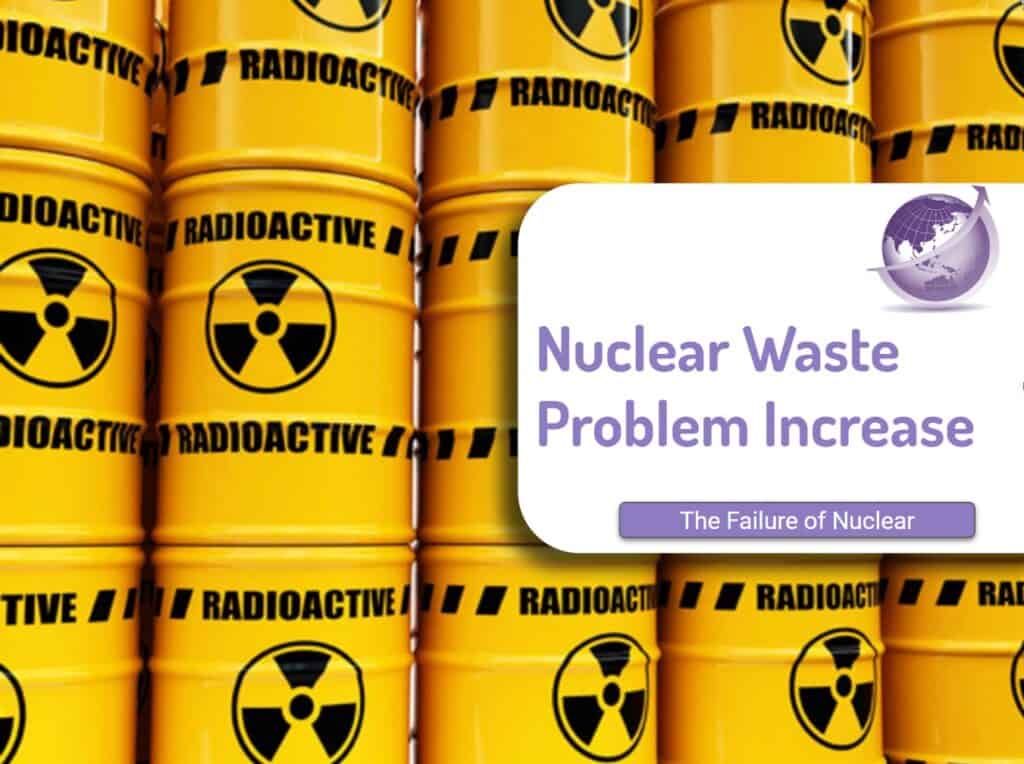Small modular nuclear power plants or nuclear SMR reactors have been talked about for the past decade to overcome the issue with conventional large nuclear. An example is the Hinckley C plant in UK. SMR have the same issues as large plants.
- Waste not addressed
- Absence of social license (or willingness to accept a nuclear reactor in your back yard.
- 18 different designs
- 37 variants
- The first one by 2029
- Under 300 MW in total
- More toxic
- Cost reduction by “factory line” overhyped
Modular units, made under factory conditions should lower costs. Bespoke large systems are very expensive. Features include
- Transportable – about a container size)
- 4 to 12 units each of 50MW allow larger systems
- Provide power to smaller communities
- SMR compete with wind solar batteries and small engines.
- No dominant variants.
SMR Economics Fail the “Pub Test”
SMR technology was investigated in the 1950’s and 60’s. The technology is much the same today as half a century ago. In engineering, the question is how many iterations to get economies of scale of manufacturing.T Economies of scale can be both internal and external. Internal economies are caused by factors within a single company while external factors affect the entire industry. Generally, it is U shaped curve. For a discussion, see Investopedia. In most engineering one needs to build a dozen or so prototypes. So if all the manufacturing was done by 1 manufacturer, then a doubling of production will drive costs down by about 10%. A general rule of thumb in manufacturing is you would need to build at least 2 or 3 times more than existing number of nuclear plants. That is about 700 units to get costs down by 50%.
This figure shows how different SMR designs all have similar overnight costs. There is no efficiency at this low level of manufacturing.

Small nuclear reactor advocates refuse to learn the lessons of the past says Michael Barnard in his analysis. (Medium)
Small modular reactors won’t achieve economies of manufacturing scale, won’t be faster to construct, forego efficiency of vertical scaling, won’t be cheaper, aren’t suitable for remote or brownfield coal sites, still face very large security costs, will still be costly and slow to decommission, and still require liability insurance caps. They don’t solve any of the problems that they purport to while intentionally choosing to be less efficient than they could be. They’ve existed since the 1950s and they aren’t any better now than they were then.
Michael Barnard 2021
Most of the attention and funding is misguided at best, and actively hostile to climate action at worst

SMR Nuclear Companies
| Company | Stated Timetable | Size and Notes | Website |
|---|---|---|---|
| NuScale | 2029 | 50 MW per unit, in combination | NuScale Power |
| Radiant Energy | 2026 | 4 MW size for remote communities, disaster areas, and bases. | Radiant Energy |
| Rolls Royce | 2029 | 417 MWh 16m long, 4m in diameter | Rolls Royce |
| TerraPower | 2030? 3 years regulation 5 year build | 345MW fast reactor Natrium with GE Hitachi in Wyoming | Terra Power Travelling Wave |
| Okla | Denied application in Jan 2022. 2023. Okla won EOI for Eielson Air Force Base in Alaska for 2027 | 4 MWth (~ 1.5 MWe) Objective was 40 years without refueling | Oklo website no information Air Force Contract |
| Pele Project (BWXT, Northrop Grumman, Aerojet Rocketdyne, and Torch Technologies | 2024 | 1 to 5MW | Pele Project |
NuScale
NuScale plans to become the first advanced nuclear power company to IPO next year. The company will go public by SPAC with an expected valuation of $1.9 billion after it received a total of $1.3 billion in investments from companies like Samsung and Segra Capital. As governments seek to reduce the effects of climate change, some look to advanced nuclear tech to meet zero-carbon goals.
NuScale CEO John Hopkins says their small, modular, light-water reactors are designed to be safer than traditional reactors. Light-water reactors, alternatively to deuterium reactors, will stop chain reactions if coolant is lost to prevent a meltdown. These reactors are useful for niches like isolated communities that are disconnected from larger electric grids, but manufacturers hope that they will scale in the future. Unlike other nuclear startups like Oklo, NuScale licenses its technology and does not manufacture reactors.
NuScale has more than $400 million in funding by the U.S. Department of Energy (DOE) since 2014 to accelerate the development and deployment of SMRs.
NuScale Regulatory Pathway
NuScale is hoping to build the Carbon Free Power Project with multiple small modular reactors (SMR) at the Idaho National Laboratory, with the first coming online in 2029 and full plant operation in 2030. US Regulatory Approval granted in 2021 was confirmed again in July 2022 (Reuters)
This follows on from the U.S. Nuclear Regulatory Commission (NRC) which issued its final safety evaluation report on NuScale Power’s SMR design in 2020, with a full design certification by August 2021.
NuScale and UTMPS Project
NuScale and the Utah Associated Municipal Power Systems (UAMPS) announced costs of a 462-megawatt small modular reactor (SMR) have risen dramatically. As Michael Liebriech says when you adjust the quoted $89/MWh for the $30/MWh IRA money plus $1.4bn in direct subsidy, by his calculations that’s a projected LCOE of $129.50/MWh in 2022 money. And there’s still seven years before construction is complete. He bets that the budget will rise further

Oklo Nuclear SMR Reactors
Conventional reactors use moderators like water to slow neutrons down before they split, or fission, uranium and plutonium atoms. Oklo’s reactors won’t use moderators, enabling the construction of much smaller plants and allowing neutrons to move faster.
Faster-moving neutrons can sustain nuclear fission with a different type of fuel. Compared to traditional reactors, Oklo’s fuel source will be enriched with a much higher concentration of the uranium-235 isotope, which fissions more easily than the more common uranium-238.
Oklo’s first reactor will generate 1.5 megawatts of electric energy, and uses used fuel recovered from an experimental reactor at the Idaho National Laboratory that was shut down in 1994. . The first reactor will use a unique uranium fuel source provided by the Laboratory. Natural uranium consists of more than 99 percent uranium-238 and about 0.7 percent uranium-235. In conventional nuclear reactors, uranium is enriched to include up to 5 percent uranium-235. The uranium fuel in Oklo’s reactors will be enriched to include between 5 and 20 percent uranium-235.
Oklo says the plant will run for 20 years without having to refuel in its lifetime. Their objective is to have plants run for 40 years without refuelling.
TerraPower
Terrapower has 3 different technologies. In the US, Bill Gates’ TerraPower is building a $4 billion advanced nuclear plant in Wyoming with government funding.
Natrium Design
TerraPower and GE Hitachi Nuclear Energy brought together their decades of unparalleled design expertise and technical capabilities to develop the Natrium™ technology, which features a cost-competitive sodium fast reactor combined with a molten salt energy storage system. Yahoo News (Jan 2022) says Terrapower will join with the Japan Atomic Energy Agency (JAEA) and Mitsubishi Heavy Industries Ltd to build the high-tech facility in Wyoming. It is set to open its Natrium plant in 2028. The US government will provide funding to cover half of the US$4 billion ($5.56 billion) project.
Molten Salt Reactor
TerraPower’s MCFR is a type of molten salt reactor (MSR) – meaning molten, or liquid, salts serve as both the reactor’s coolant and fuel. The MCFR design specifically requires molten chloride salt, which allows for fast spectrum operation. In the fast neutron spectrum, neutrons are not slowed down (e.g. by colliding with water or graphite) and move very quickly making the fission reaction more efficient.
In MCFR cores, nuclear fission occurs and heats the fuel salts directly. The MCFR then distributes heat from the molten fuel salt through a heat exchanger to an inert salt in a second loop. Heat from the non-nuclear secondary loop is then safely used for electricity generation, process heat or thermal storage.
Travelling Wave Reactor
The innovation of the TWR design is that in the centre of the core sit rods of enriched uranium (U-235), surrounded by rods of depleted or natural uranium (U-238). The U-235 serves as an initiator, kickstarting the travelling wave reaction – a slow-moving chain reaction of concentric waves of fission. The travelling wave reaction will then slowly convert the depleted uranium to fissionable plutonium. Periodically, to sustain the fission reaction, the in-vessel fuel handling machine shuffles the fuel, swapping expired fuel rods from the centre of the core for fresh fuel rods from the outer edge.
Most reactors in use today need to be refuelled every 18 to 24 months. Terrapower says the MCFR can be fueled as part of a continuous process that does not involve extended shutdowns, the opening of the reactor vessel, or movement of numerous fuel assemblies.
Rolls Royce
Rolls Royce have been servicing the British Navy nuclear for decades with the largest workforce in UK. They have just recently announced they are gong to re-enter the market for SMR. They say they are walk away safe for emergency shutdown. A meltdown or explosion is impossible. The size is the size of 2 football pitches, built on a seismic raft and can be built inside a canopy. Say they can build within 4 years, rather than 20 years and good for 20 years.
The reactor themselves will 16m long, 4m in diameter 417 MWh LCOE of $85 MWh. So UK Govt have tipped in £250m. Hope to have the first site in 2032 and have another 16 at about £2.5b each.
But still no suggestion on how to deal with the waste.





Radiant
Radiant Nuclear is developing a microreactor that they call the “world’s first portable, zero-emissions power source.” The idea for the microreactor, called Kaleidos, stems from CEO Doug Bernauer’s time working at SpaceX, where he was tasked with devising methods for producing enough power on Mars to allow future colonies to survive and also travel between Earth and the red planet. They have raised some money. See YouTube
Other Countries’ efforts
China, whose nuclear energy production is up 400% since 2011, plans to spend $440 billion on 150 new plants by 2035. The 200-gigawatt plan would produce enough power for more than 260 million people. And amidst the European gas crisis,
France has backed off plans to close 14 nuclear plants
The most sensible thing to do is keep existing nuclear plants in operation. Refurbish. Maintain. It is cheaper than trying to build new ones as part of the reduction in CO2 reduction plans.
Nuclear Power Projections
Some say global nuclear capacity up 21% by 2030 and 82% by 2050. These projections often come from nuclear proponents and many see this as extremely optimistic.
Waste from Nuclear SMR
SMR has suggested there would be less waste from SMR but a study published May 31 2022 in Proceedings of the National Academy of Sciences has reached the opposite conclusion. “Our results show that most small modular reactor designs will actually increase the volume of nuclear waste in need of management and disposal, by factors of 2 to 30 for the reactors in our case study,” says lead author Lindsay Krall.
Micro Nuclear Reactors
Micro-reactors are in the news. These are 1 to 5MW capacity. Radiant, Ultra Safe Nuclear Corporation and Westinghouse have been awarded US Department of Energy funding totalling USD3.9 million for front-end engineering and experiment design. The test bed facility is at Idaho National Laboratory.
- A Microreactor project at Idaho National lab is doing research on a tiny, relatively inexpensive nuclear reactor. It’s more of a nuclear battery, than an SMR, and is in the range of 1 to 5MW. Its use would be in places like Alaska or remote communities without access to wind or solar.
- The first prototype MARVEL reactor (Microreactor Applications Research Validation and Evaluation) and target date for operation in late 2023, making it the first advanced microreactor in the United States.
- CNBC reported in Jun 2022 a single microreactor could power a small community. A hospital or remote military base of 1,000 to 10,000 is a small community.
- Ultra Safe Nuclear Corporation (USNC), based in Seattle, Washington, is in last-ditch attempts to stave off collapse [3].
- Westinghouse achieves a crucial milestone in microreactor development, paving the way for compact nuclear power. The eVinci microreactor promises efficient, long-lasting energy production on a small footprint, but concerns about nuclear waste and safety persist.
References for Nuclear SMR Reactors
- MIT Newsletter. https://news.mit.edu/2020/oklo-nuclear-energy-1113
- Eye-popping new cost estimates released for NuScale small modular reactor 2023 David Schlissel https://ieefa.org/resources/eye-popping-new-cost-estimates-released-nuscale-small-modular-reactor
- ‘Micro’ nuclear reactor start-up backed by Britain goes bust Nov 2024 https://www.msn.com/en-us/news/technology/micro-nuclear-reactor-start-up-backed-by-britain-goes-bust/ar-AA1tcsc4
- Westinghouse Completes Study for First eVinci Microreactor Experiment Sept 2024 https://www.energy.gov/ne/articles/westinghouse-completes-study-first-evinci-microreactor-experiment









